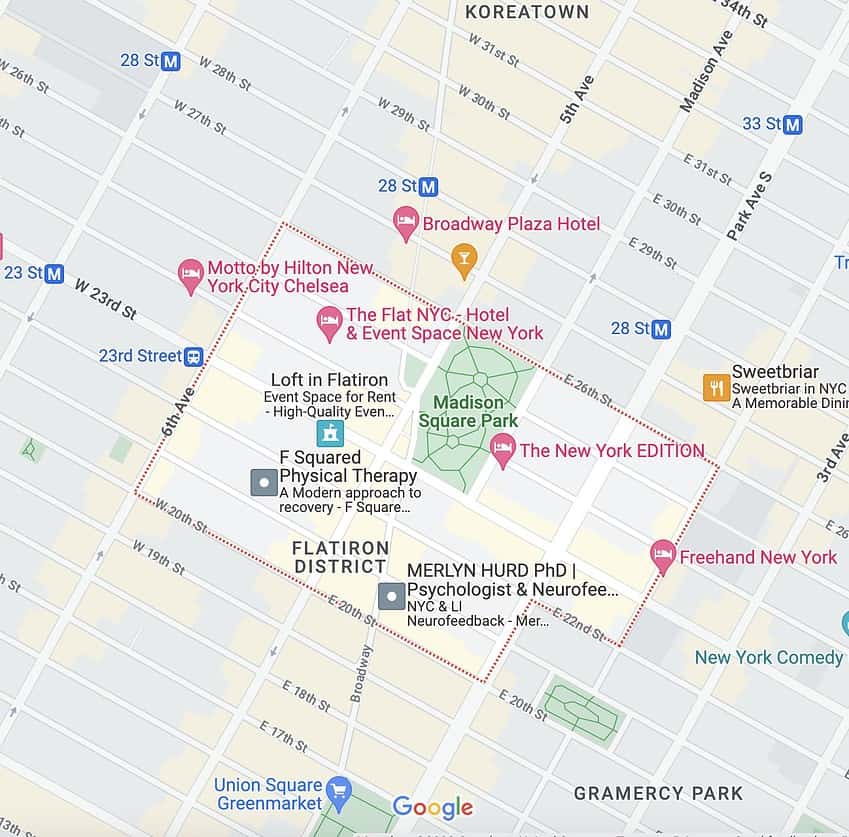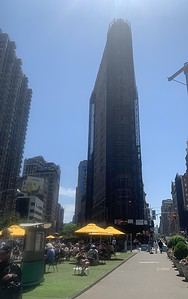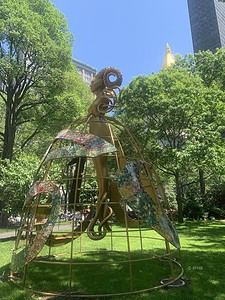Landmarks and attractions in the Flatiron NoMad district.
- The Flatiron Building: The Flatiron Building is an architectural marvel that has become an iconic symbol of New York City. This triangular-shaped skyscraper at the intersection of Fifth Avenue, Broadway, and 23rd Street is a testament to the city’s rich architectural heritage. Built in 1902, the building stands 285 feet tall and offers a striking view with its Beaux-Arts design. Don’t forget to snap pictures of this historical gem and admire its timeless beauty.
- Tin Pan Alley: History buffs and music enthusiasts should stop at Tin Pan Alley, just a few blocks north of the Flatiron Building. In the late 19th and early 20th centuries, this area was a vibrant hub for songwriters and music publishers. It earned its nickname due to the constant sound of piano tunes from numerous music shops. Many timeless American classics were composed here, including “Take Me Out to the Ball Game” and “God Bless America,” were composed here. Though the original buildings are no longer standing, the legacy of Tin Pan Alley lives on, and you can still feel the creative energy that once flowed through these streets.
- The Clocktower: Towering above Madison Square Park, the MetLife Tower, also known as the Clocktower, is a historic and eye-catching landmark. Completed in 1909, it was once the tallest building in the world, with its distinctive clock faces and ornate detailing adding to its grandeur. Today, the tower houses the New York Edition Hotel, where you can enjoy luxurious accommodations and breathtaking city views from the Clocktower’s elegant bar and restaurant.
- Gilded Lady Mural: One of the district’s hidden gems is the Gilded Lady mural, located at 106 East 19th Street. This stunning street art pays homage to the district’s rich history and culture. Created by artist Tristan Eaton, the mural depicts a gilded, multi-faceted woman whose vibrant colours and intricate design captivate viewers. It serves as a reminder of the district’s transformation and vibrant artistic spirit over the years.
- New York Life Building: Standing tall on Madison Square Park, the New York Life Building is an architectural gem that reflects the neighbourhood’s storied past. Completed in 1928, this 40-story Art Deco skyscraper features intricate ornamentation, including a stunning gilded pyramid-shaped roof. The building serves as the headquarters for the New York Life Insurance Company and is a testament to the district’s rich architectural heritage.
What to do in the Flatiron NoMad District if You are a Tourist
Flatiron NoMad district is one of New York City’s most vibrant and diverse neighbourhoods. Nestled between Midtown Manhattan and downtown, this area is home to iconic landmarks, trendy eateries, and a buzzing atmosphere that will leave you wanting more. Whether you’re a local looking for a fun day out or a visitor exploring the Big Apple, here are some must-see attractions and activities to check out in the Flatiron NoMad district.
- Stroll Through Madison Square Park: Start your day with a leisurely walk through Madison Square Park, a lush green oasis in the city’s heart. Take a moment to admire the beautiful landscaping, grab a coffee from a nearby cafe, and relax on one of the park’s benches. Watch for the famous Shake Shack, where you can enjoy a delicious burger and shake for a quick bite. Personally, I am not impressed with their fries, but the burgers are terrific.
- Explore Eataly: Eataly, a massive Italian marketplace in several cities, is a foodie’s paradise in the Flatiron NoMad district. Step inside and immerse yourself in a world of gourmet Italian ingredients, fresh produce, and mouthwatering dishes. Indulge in handmade pasta, authentic pizza, and gelato for a truly satisfying culinary experience.
- Visit The Harry Potter Store or the Museum of Sex: From toys to rare collectibles, Harry Potter New York houses the largest collection of Harry Potter and Fantastic Beasts products under one roof. If you’re feeling adventurous, head to the Museum of Sex for a unique and eye-opening experience. This museum explores the cultural significance of human sexuality through thought-provoking exhibits and interactive displays.
- Check out the Chelsea Flea Market on weekends: Not to be confused with the Chelsea Market to the east., the Chelsea Flea Market has a rich history from the 1970s. It began as a small gathering of vendors selling second-hand goods and collectibles in the parking lot of the Chelsea Hotel. Today, it is located on West 25th Street, between Broadway and 6th Avenue, offering visitors a vibrant and diverse shopping experience. But do not expect to find any bargains.
- Experience Korean Cuisine: Just north of Flatiron is Koreatown. Explore the vibrant streets and immerse yourself in the rich culture of Korea right in the heart of New York City.
What is the architecture of a Flatiron Building?
The architecture of Flatiron Buildings, regardless of their location, holds several special features and significance:
- Triangular Shape: The most distinctive characteristic of Flatiron Buildings is their triangular shape. This design allows the building to fit into irregularly shaped lots or prominent intersections, creating a visual focal point and maximizing space usage.
- Architectural Styles: Flatiron Buildings often showcase various architectural styles, such as Romanesque Revival, Beaux-Arts, and other artistic influences. The intricate detailing, use of materials, and ornate ornamentation contribute to their aesthetic appeal and historical significance.
- Landmark Status: Many Flatiron Buildings have acquired landmark status, recognizing their architectural and historical importance. Their preservation and protection ensure that future generations can appreciate and learn from these iconic structures.
- Symbolism and Identity: Flatiron Buildings have become symbols of their respective cities, representing the architectural heritage, urban development, and cultural identity of the surrounding areas. They often attract tourists and serve as iconic backdrops in photographs and movies.



